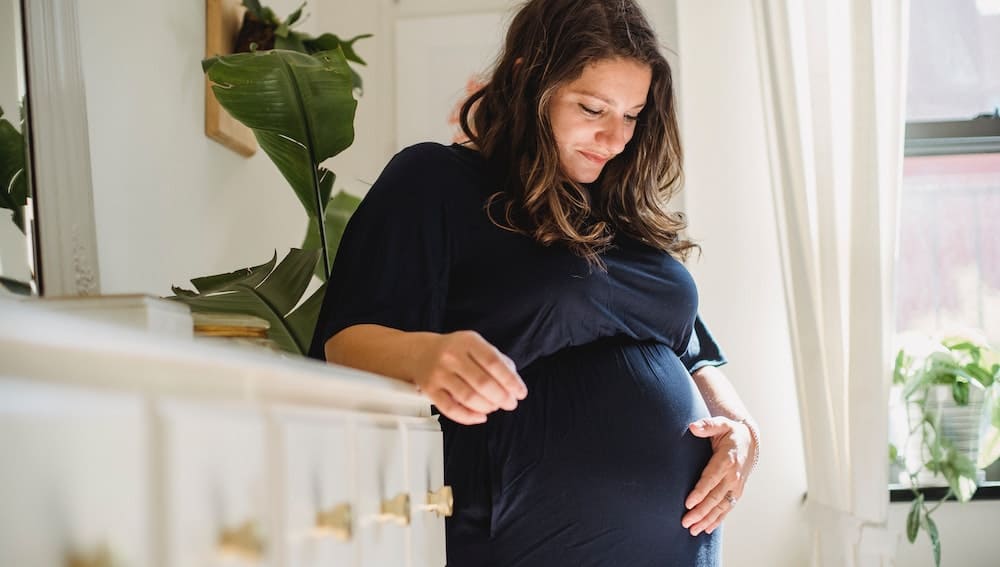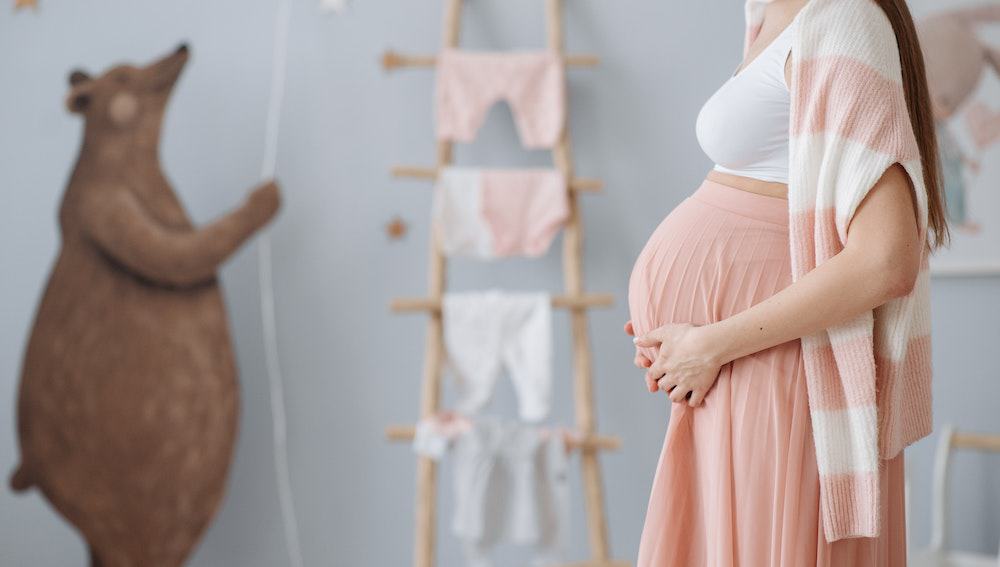Plus size pregnancy can come with its own unique set of challenges and concerns. One of these concerns is the development of a “B belly” during pregnancy.
This term refers to the way a pregnant belly can appear on a plus size woman, with a smaller bump on top and a larger, lower bump resembling the letter B. This can be due to a number of factors, including excess weight in the abdomen and the position of the baby.
Understanding plus size pregnancy is important for expectant mothers who fall into this category. It is important to note that plus size women can have healthy pregnancies, but they may require additional monitoring and care.
Women who are plus size may be at a higher risk for certain complications during pregnancy, such as gestational diabetes, preeclampsia, and preterm birth. It is important for these women to work closely with their healthcare provider to manage their health throughout pregnancy.
Key Takeaways
- Plus size pregnancy can lead to the development of a “B belly” due to factors such as excess weight in the abdomen and position of the baby.
- Plus size women may require additional monitoring and care during pregnancy to manage potential health risks.
- Working closely with a healthcare provider is important for managing the health of plus size women during pregnancy.
Understanding Plus Size Pregnancy
Pregnancy is an exciting time for any woman, regardless of her body size. However, for plus-size women, there are some unique considerations that need to be taken into account.
Being overweight or obese can increase the risk of certain complications during pregnancy, such as gestational diabetes, high blood pressure, and pre-eclampsia.
Plus-size pregnancy is defined as a pregnancy in which the woman has a body mass index (BMI) of 30 or higher. It is important to note that BMI is not a perfect measure of health, and some women who are considered plus-size may be perfectly healthy.
However, it is still important to be aware of the potential risks and to take steps to minimize them.
One of the biggest challenges of plus-size pregnancy is the increased risk of complications. However, with proper care and management, many women are able to have healthy pregnancies and deliver healthy babies.
Some of the steps that can be taken to minimize the risk of complications include:
- Maintaining a healthy diet and getting regular exercise
- Monitoring blood sugar levels and blood pressure
- Attending all prenatal appointments and following the recommendations of your healthcare provider
- Discussing any concerns or questions with your healthcare provider
It is also important to note that every pregnancy is different, and what works for one woman may not work for another. It is important to work closely with your healthcare provider to develop a plan that is tailored to your individual needs and circumstances.
In conclusion, plus-size pregnancy does come with some unique considerations and potential risks, but with proper care and management, many women are able to have healthy pregnancies and deliver healthy babies.
By working closely with your healthcare provider and taking steps to minimize the risk of complications, you can increase your chances of having a successful pregnancy and a healthy baby.
B Belly and D Belly Explained
During pregnancy, women’s bodies undergo several changes, including weight gain and a growing belly. Many women experience a “baby bump” that is round and protruding. However, some women may develop what is known as a “B belly” or “D belly.”
A B belly is a term used to describe a pregnant woman’s belly when it appears as two distinct bulges, resembling the letter “B.” The top half of the belly is round and protruding, while the bottom half appears flatter and wider.
This can occur when a woman has excess fat in her midsection before becoming pregnant, which can make it difficult for the uterus to expand evenly.
A D belly, on the other hand, is when the lower half of the belly protrudes outward, creating a shape that resembles the letter “D.” This can happen when the baby’s position causes the uterus to bulge outward in a particular direction.
It’s essential to note that having a B belly or D belly does not affect the health of the baby or the mother. It’s merely a cosmetic issue that some women may feel self-conscious about.
There are several ways to minimize the appearance of a B belly or D belly during pregnancy. Wearing supportive clothing, such as maternity belts or compression garments, can help distribute the weight of the belly more evenly.
Engaging in regular physical activity, such as walking or swimming, can also help tone the muscles in the midsection and prevent excess fat from accumulating.
Overall, a B belly or D belly is a common occurrence during pregnancy and is nothing to be concerned about. By taking care of oneself and staying active, women can feel more confident and comfortable throughout their pregnancy journey.
Also, read an interesting post on How To Get Rid Of Stomach Crease Lines
Health Risks and Management
Pregnancy can be a challenging time for anyone, but for plus-size women, there may be additional health concerns to consider. It’s essential to manage these risks to ensure a healthy pregnancy and delivery.
One of the most significant risks is gestational diabetes, which is more common in women who are overweight or obese. This condition can cause high blood sugar levels and may lead to complications for both the mother and baby.
To manage this risk, doctors may recommend monitoring blood sugar levels and making dietary changes.
Preeclampsia is another concern for plus-size women. This condition can cause high blood pressure and damage to organs such as the kidneys and liver. It can also lead to preterm delivery.
To manage this risk, doctors may recommend frequent blood pressure checks and close monitoring of the mother’s health.
High blood pressure is also a concern for plus-size women during pregnancy. This condition can lead to complications such as preterm delivery, stillbirth, and miscarriage. To manage this risk, doctors may recommend medication and close monitoring of blood pressure levels.
Back pain is a common issue for all pregnant women, but it can be more severe in plus-size women. This pain can be due to the additional weight that the spine has to support. To manage this risk, doctors may recommend exercises to strengthen the back muscles and provide pain relief.
Overall, it’s essential for plus-size women to work closely with their healthcare providers to manage any health concerns during pregnancy. By taking steps to manage these risks, women can have a healthy pregnancy and delivery.
The Centers for Disease Control and Prevention recommend that plus-size women speak with their healthcare providers before becoming pregnant to discuss any health concerns and develop a plan for a healthy pregnancy.
Importance of Monitoring
Monitoring is an essential aspect of any pregnancy, and it becomes even more crucial when it comes to plus-size pregnancy, especially with B belly.
Women with a higher BMI have a higher risk of developing gestational diabetes, high blood pressure, and other complications during pregnancy. Thus, it is critical to monitor their health and the baby’s growth regularly.
Wireless monitoring is an excellent option for plus-size pregnant women. It allows them to track their health and baby’s growth from the comfort of their own homes.
This technology enables women to monitor their blood pressure, blood sugar, and other vital signs without having to visit the doctor’s office frequently.
Body Mass Index (BMI) is a crucial factor in plus-size pregnancy. Women with a BMI of 30 or higher are considered obese and have a higher risk of complications during pregnancy.
Thus, it is essential to monitor their weight gain throughout pregnancy. Women with a higher BMI should aim to gain less weight during pregnancy than those with a lower BMI.
Regular monitoring of weight gain is crucial for plus-size pregnant women. It helps them keep track of their weight gain and ensure that it is within the recommended range.
Women with a higher BMI should aim to gain between 11 and 20 pounds during pregnancy, while those with a lower BMI should aim to gain between 25 and 35 pounds.
In conclusion, monitoring is essential for plus-size pregnant women, especially with B belly. Regular monitoring of vital signs, weight gain, and other health indicators can help prevent complications during pregnancy and ensure a healthy pregnancy and baby.
Understanding Apron Belly
Apron belly, also known as B belly, is a condition where the lower belly hangs down, creating a shape that resembles the letter “B.” It is common in plus-size women, especially during pregnancy.
The apron belly is caused by several factors, including weakened abdominal muscles, lax connective tissue, and fascia.
Fascia is a thin layer of connective tissue that surrounds the muscles, organs, and bones in the body. When the fascia is weak, the abdominal muscles are not held in place, causing the belly to sag.
Wearing a band across the belly can help provide support and reduce discomfort. The band should be worn below the waistband and above the hips. It should be snug but not too tight, as it can restrict breathing and circulation.
Maintaining fascial health is also important in reducing the appearance of apron belly. Simple exercises such as walking, stretching, and yoga can help improve fascial health and strengthen the abdominal muscles.
In some cases, surgery may be necessary to remove excess skin and fat from the belly. However, this should be considered a last resort after other options have been exhausted.
Overall, understanding the causes and treatments of apron belly can help individuals feel more confident and comfortable in their bodies.
Maternity Clothes for Plus Size Pregnancy
Pregnancy is a beautiful journey, but it can be challenging to find comfortable and stylish clothes, especially for plus-size women.
Maternity clothes are designed to provide comfort and support during pregnancy, and it’s essential to find the right fit to accommodate a growing bump.
When it comes to plus-size maternity clothes, there are many options available that can cater to different styles and needs. Here are a few things to keep in mind when shopping for plus-size maternity clothes:
- Look for stretchy fabrics: Stretchy fabrics like spandex and elastane can provide a comfortable fit and accommodate a growing bump. Look for clothes that have a blend of stretchy fabrics to ensure maximum comfort.
- Opt for loose-fitting clothes: Loose-fitting clothes can provide ample room for a growing bump and prevent any discomfort. Flowy dresses, tunics, and tops with empire waists can provide a comfortable and stylish look.
- Invest in maternity leggings: Maternity leggings are a must-have for any pregnant woman, especially for plus-size women. They provide support to the growing belly and can be paired with different tops and dresses.
- Consider adjustable clothes: Clothes with adjustable features like drawstrings, elastic bands, and ties can provide a customized fit and adjust to a growing bump.
- Don’t forget about bras: A comfortable and supportive bra is essential during pregnancy, especially for plus-size women. Look for bras with wider straps and a supportive band to accommodate a growing bust.
In conclusion, finding the right maternity clothes during pregnancy can be challenging, but it’s essential to prioritize comfort and support. Plus-size women have many options available to them, and with a little bit of research and effort, they can find clothes that cater to their style and needs.
Exercise and Diet
Maintaining a healthy diet and exercise routine during pregnancy is essential for both the mother and the baby’s health.
Plus-size pregnant women may face additional challenges, but with the right approach, they can still have a healthy pregnancy.
Exercise
Exercise is an essential part of a healthy pregnancy, regardless of size. However, plus-size pregnant women may need to modify their exercise routine to ensure safety and comfort. Low-impact exercises such as walking, swimming, and prenatal yoga are great options.
These exercises help maintain muscle tone, improve circulation, and reduce the risk of gestational diabetes and high blood pressure.
It’s important to avoid high-impact exercises that can put too much stress on the joints, such as running or jumping. It’s also essential to listen to your body and avoid overexertion.
If you experience any pain or discomfort during exercise, stop immediately and consult with your healthcare provider.
Diet
A healthy diet during pregnancy is crucial for both the mother and the baby’s health. Plus-size pregnant women may be at a higher risk of gestational diabetes and high blood pressure, making it even more important to maintain a healthy diet.
A balanced diet should include a variety of fruits, vegetables, whole grains, lean proteins, and healthy fats. It’s essential to avoid processed and sugary foods, which can lead to excessive weight gain and other health complications.
Plus-size pregnant women should also pay attention to portion sizes and avoid overeating. Eating smaller, more frequent meals can help regulate blood sugar levels and prevent excessive weight gain.
In summary, maintaining a healthy diet and exercise routine during pregnancy is crucial for both the mother and the baby’s health. Plus-size pregnant women may face additional challenges, but with the right approach, they can still have a healthy pregnancy.
Postpartum Care
After giving birth, it is important for women with a plus size pregnancy B belly to take care of their bodies during the postpartum period. This period can be challenging, both physically and emotionally, and requires special attention to ensure a healthy recovery.
For women who have had a c-section, it is important to follow the doctor’s instructions for care and recovery. This may include taking pain medication, getting plenty of rest, and avoiding strenuous activities for several weeks. It is also important to keep the incision site clean and dry to prevent infection.
For women who have experienced diastasis recti, it is important to work with a physical therapist or other healthcare professional to develop a safe and effective exercise program. This may include exercises to strengthen the abdominal muscles and improve posture.
Regardless of the type of delivery, it is important for women to take care of their bodies by eating a healthy diet, staying hydrated, and getting plenty of rest. It is also important to seek support from family, friends, or a healthcare professional if needed.
Overall, taking care of oneself during the postpartum period is crucial for a healthy recovery after a plus size pregnancy B belly. By following the recommended guidelines and seeking support when needed, women can ensure a smooth transition to motherhood.
Embracing Your Pregnancy Journey
Pregnancy is a beautiful journey that brings new experiences and challenges for every woman. For plus-size women, the journey can come with its own unique set of challenges, including the development of a “B belly.”
This refers to the appearance of two bulges on either side of the belly button, creating a shape that resembles the letter “B.”
While some women may feel self-conscious about their changing bodies, it’s important to remember that every pregnancy is different and every body is beautiful. Embracing your pregnancy journey means accepting and celebrating the changes that come with it.
One way to celebrate your pregnancy journey is through maternity photos. Many plus-size women may feel hesitant to take these photos, but they can be a wonderful way to capture the beauty of your changing body and the love you have for your growing baby.
There are many photographers who specialize in plus-size maternity photography and can help you feel confident and beautiful during your shoot.
For women who have had prior pregnancies, it’s important to remember that every pregnancy is different. Just because you didn’t experience a B belly in a previous pregnancy doesn’t mean you won’t in your current one.
It’s also important to note that stretch marks are common during pregnancy, regardless of body size.
If you are experiencing a B belly or feel self-conscious about your plus-size pregnancy belly, there are options to help you feel more comfortable. Maternity support belts can provide added support and help distribute the weight of your growing baby more evenly.
Additionally, there are many stylish and comfortable plus-size maternity clothes available that can help you feel confident and comfortable throughout your pregnancy.
In the end, embracing your pregnancy journey means accepting and celebrating the changes that come with it. Whether you have a B belly or not, every body is beautiful and every pregnancy is a unique and special experience.
Frequently Asked Questions
What are the different types of pregnancy belly shapes?
During pregnancy, women’s bodies undergo significant changes to accommodate the growing fetus. The most common belly shapes include round, high, low, and B-shaped belly.
What causes a B-shaped belly during pregnancy?
A B-shaped belly during pregnancy is usually caused by excess fat in the lower abdomen. This can be due to genetics, lifestyle, or a combination of both.
Can a B-shaped belly round out during pregnancy?
In most cases, a B-shaped belly will round out during pregnancy as the baby grows and the uterus expands. However, this may not always be the case, and some women may still have a B-shaped belly after giving birth.
How does a B belly differ from an apron belly during pregnancy?
An apron belly is a type of belly shape that occurs when excess fat and skin hang down over the pubic area. It is usually caused by significant weight gain or loss. A B-shaped belly, on the other hand, is characterized by excess fat in the lower abdomen.
At what point does a B belly turn into a D belly during pregnancy?
There is no specific point at which a B-shaped belly turns into a D-shaped belly during pregnancy. The shape of a woman’s belly during pregnancy can vary depending on various factors, including the size and position of the baby.
Are there any ways to fix a B-shaped belly during pregnancy?
There is no guaranteed way to fix a B-shaped belly during pregnancy. However, maintaining a healthy diet and engaging in regular exercise can help reduce excess fat in the lower abdomen and improve overall health.
It is important to consult with a healthcare provider before starting any new exercise routine during pregnancy.
Related Posts:

Nazeli Gevorgyan studied at Yerevan State Medical University and is an Obstetrics/Gynecology resident



